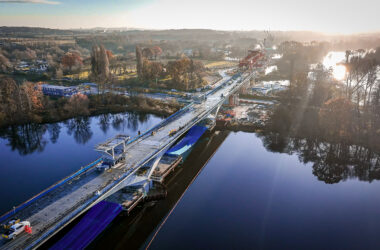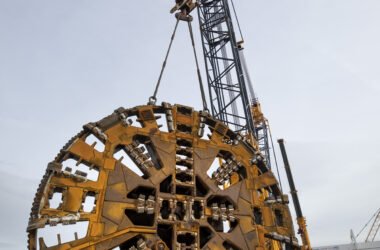Today will see the launch of NASAs huge Space Launch System (SLS)
The SLS is a critical part of the American’s space agencies attempt to bring humans back to the moon. Today’s “Artemis I” mission will see an unmanned SLS blast into space carrying an Orion vehicle 40,000 miles past the far side of the moon.
The mission will last 42 days and will take off from Kennedy Space Center, the same facility that was home to the Apollo lunar missions more than 50 years ago.

The only human crew members abroad the Orion for this first test are going to be mannequins ( and a Snoopy toy which will float freely around the cabin to demonstrate zero gravity to anyone watching the live stream ). These mannequins will let Nasa evaluate how its next-gen spacesuits perform and the radiation levels the ‘crew’ are subjected to.
The test flight is the first major flight in the programme that is designed to return humans to the moon and eventually land them on Mars
You can find out more about NASA assembled the giant SLS rocket in our Infographic.
What to expect for Todays Artemis launch

Before the Artemis I mission blasts off on its way around the Moon, the team at Kennedy Space Center run through a complex launch countdown that kicks off around two days before liftoff.
What is the difference between “L Minus” and “T Minus” times in the launch countdown
The official countdown will refer to “L Minus” and “T Minus” times.
“L minus” indicates how far away we are from liftoff in hours and minutes.
“T minus” time is a sequence of events that are built into the launch countdown.
Pauses in the countdown, or “holds,” can be built into the countdown to allow the launch team to target a precise launch window, and to provide a wider window of time for tasks without impacting the overall schedule.
During planned holds in the countdown process, the countdown clock is intentionally stopped and the T- time also stops. The L- time, however, continues to advance.
SLS launch August 29th 2022)
The countdown clock for todays launch started hours ago at L-46 hours 40 minutes. When the sun-rose today there were only L-15 hours remaining. At this point the NASA launch team will have been working down the very final steps to launch. These now include –
L-15 hours and counting
- All non-essential personnel leave Launch Complex 39B (L-12H – L-10H)
- Ground Launch Sequencer (GLS) Activation (L-11H15M – 9H15M)
- Air-to-gaseous nitrogen (GN2) Changeover for vehicle cavity inerting (L-10H45M – Launch)
L-9 hours, 40 minutes and counting
- Built in countdown hold begins (L-9H40M – L-7H10M)
- Launch team conducts a weather and tanking briefing (L-9H40M – L-8H50M)
- Launch team decides if they are “go” or “no-go” to begin tanking the rocket (L-8H40M)
- Core Stage LO2 transfer line chilldown (L-8H15M – L-8H)
L-8 hours and counting
- Core stage LO2 main propulsion system (MPS) chilldown (L-8H – L-7H20M)
- Core stage LO2 slow fill (L-7H20M – L-7H5M)
- Core Stage LO2 fast fill (L-7H5M – L-4H15M)
- Core Stage LH2 chilldown (L-7H15M – L-7H5M)
- Core Stage LH2 slow fill start (L-7H5M – L-6H15M)
- Core Stage LH2 fast fill (L-6H15M – L-5H5M)
- Core Stage LH2 topping (L-5H5M – L-5H)
L-5 hours and counting
- Core Stage LH2 replenish (L-5H – Launch)
- ICPS LH2 ground support equipment (GSE) and tank chilldown (L-4H45M – L-4H30M)
- ICPS LH2 fast fill start (L-4H30M – L-3H30M)
- Orion communications system activated (RF to Mission Control) (L-4H20M – L-3H45M)
- Core stage LO2 topping (L-4H15M– L-3H55M)
- Core Stage LO2 replenish (L-3H55M – Launch)
- ICPS L02 MPS chilldown (L-3H55M– L-3H45M)
- ICPS L02 fast fill (L-3H45M– L-2H55M)
- ICPS LH2 validation and leak test (L-3H30M – L-3H15M)
- ICPS LH2 tank topping start (L-3H15M – L-2H55M)
L-3 hours and counting
- ICPS/Space Launch System (SLS) telemetry data verified with Mission Control and SLS Engineering Support Center (L-2H55M – L-2H45M)
- ICPS LO2 validation and leak test (L-2H55M – L-2H30M)
- ICPS LH2 replenish (L-2H50M – Launch)
- ICPS LO2 topping (L-2H30M – L-2H10M)
- ICPS LO2 replenish (L-2H10M – Launch)
L-50 minutes and counting
- Final NASA Test Director briefing is held (L-50M)
L-40 minutes and holding
- Built in 30-minute countdown hold begins (L-40M)
L-15 minutes and holding
- The launch director polls the team to ensure they are “go” for launch
T-10 minutes and counting
- Ground Launch Sequencer (GLS) initiates terminal count (T-10M)
- GLS go for core stage tank pressurization (T-6M)
- Orion ascent pyros are armed (T-6M)
- Orion set to internal power (T-6M)
- Core Stage LH2 terminate replenish (T-5M57S)
- GLS is go for flight termination system (FTS) arm (T-5M)
- GLS is go for LH2 high flow bleed check (T-4M40S)
- GLS is go for core stage auxiliary power unit (APU) start (T-4M)
- Core Stage APU starts (T-4M)
- Core stage L02 terminate replenish (T-4M)
- ICPS LO2 terminate replenish (T-3M30S)
- GLS is go for purge sequence 4 (T-3M10S)
- ICPS switches to internal battery power (T-1M56S)
- Core stage switches to internal power (T-1M30S)
- ICPS enters terminal countdown mode (T-1M20S)
- ICPS LH2 terminate replenish (T-50S)
- GLS sends “Go for automated launch sequencer” command (T-33S)
- Core stage flight computer to automated launching sequencer (T-30S)
- Hydrogen burn off igniters initiated (T-12S)
- GLS sends the command for core stage engine start (T-10S)
- RS-25 engines startup (T-6.36S)
T-0
- Booster ignition, umbilical separation, and liftoff
More Artemis News Posts
- Solid Rocket Moon Booster fired up for critical test
- Artemis: how ever changing US space policy may push back the next Moon landing
- Infographic – How is NASA assembling its huge SLS rocket?
- The road to assembling NASAs mega-rocket.
- Uncrewed flights to the Moon to start February 2022
- Orion capsule stacked on top of Artemis 1 as moon mission approaches
- How Artemis 1 will pave the way for a human return to the Moon
- Watch – Lighting Strikes Moon-bound mega rocket
- Artemis – Countdown to SLS Launch
- Thats all folks – NASA Cancels Artemis SLS Launch
- Artemis launch heralds a new age of space exploration
- Could Artemis be the last mission for NASAs astronauts?
- The Moon – What Moon Missions are planned for 2023?
- Beyond Apollo: The Next Era of Moon Exploration with a New Generation of Astronauts








